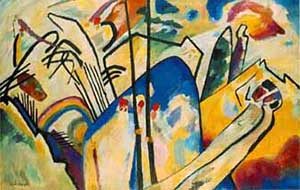Selected Papers by Diatrope Researchers
Was Leonardo da Vinci’s World Map the First to Name America?
|
 The Conception of Space in 20th Century Art by Christopher Tyler and Amy Ione. 2000. The Conception of Space in 20th Century Art by Christopher Tyler and Amy Ione. 2000.The concept of space in the twentieth century is one that mirrors views of space and vision from a myriad of perspectives. Twentieth century artists have frequently favored non-traditional approaches to compositional dilemmas. Moreover, their deconstructive approach to space seems to have brought the art of the century full circle. With Hockney we travel back to the exploratory evocations of the medieval monks who first brought visual representation out of the cultural vacuum of the post-Roman interregnum. This style, as noted, could be considered characteristic of twentieth century art, from Picasso near the beginning of the century to the digital revolution at its close, but a broader view would see the century as embracing an eclectic array of space representation styles, from the extreme perspective accuracy of the superrrealists through the filmy textural haze of Mark Rothko and Helen Frankenthaler to a world where computers present a vast array of images across spatial boundaries that even allow us to interact with these images directly. We consider a few aspects of this diverse array of styles in this brief survey, but it is hoped that this is sufficient to dispel Stella’s notion that twentieth century art has mainly focused on the arrangement of compositional elements within the flat space of the canvas. PDF |
 “Is Art Lawful?” by Christopher W. Tyler. Perspectives: Neuroscience. Science.285:673-4 (1999). “Is Art Lawful?” by Christopher W. Tyler. Perspectives: Neuroscience. Science.285:673-4 (1999).It must be an eventual hope of brain science to address the complexities of the aesthetic experience. Perception may seem to some to be a phenomenological experience inaccessible to scientific rigor, but the efforts of generations of perceptual psychologists have shown that many aspects of perception are governed by a body of lawful relationships no less tractable than those of quantum physics, for example. The extension of such relationships to the subtleties of aesthetics is another kettle of slippery fish taken up by Ramachandran and Hirstein (1999) in a thought-provoking article in the Journal of Consciousness Studies. They bring a deeper viewpoint to bear on this challenge, combining principles not only from perceptual psychology, but also from evolutionary biology, neurological deficits and functional brain anatomy to provide a new overview of the nature of art. Their treatment is novel not so much in the idea of finding perceptual rules in art, but in addressing the essence of art, the evolutionary meaning of beauty, by means of such principles. PDF |
 Rosetta Stoned?: Hockney, Falco and the sources of ‘opticality’ in Lorenzo Lotto’s ‘Husband and Wife’ by Christopher Tyler Rosetta Stoned?: Hockney, Falco and the sources of ‘opticality’ in Lorenzo Lotto’s ‘Husband and Wife’ by Christopher TylerIn his book, Secret Knowledge, David Hockney proposes that the “optical quality” of Flemish art arose around 1420 when artists such as van Eyck began to use optical devices for accurate projection onto the canvas. Although Hockney describes Lotto’s Man and Wife as the “Rosetta Stone” of their argument, analysis reveals that its perspective structure is incompatible with the logic of local optical projection. Regions that should be geometrically coherent in an optical projection display pronounced distortions, and vice versa. Such detailed evidence, and the inability of optical projection to capture windblown garments, is inconsistent with Hockney’s claim. PDF |


